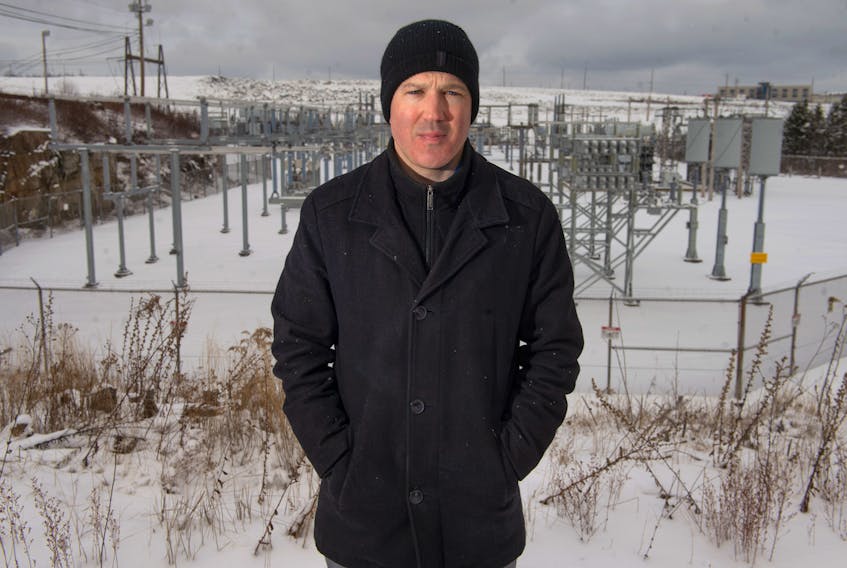A thick coat of new-fallen snow covers the sloped gravel road that leads down to the Lakeside power substation.
It’s a cold December day and there’s still snow in the air but the wind is light as Matt Drover walks toward the fenced-in array of wires, transformers and ceramic insulators that covers the equivalent of a couple of football fields at the bottom of Lakeside Park Drive.
He points up to one of the transmission towers that feed high-voltage power into 103 H Lakeside, one of about 190 substations in the Nova Scotia Power system.
“So this tower right here is 345,000 volts,” said Drover, NSP’s director of regional operations for transmission and distribution. “That’s one of our backbone lines.”
If the wind was up, Drover likely wouldn’t have the time to give a couple of visitors the lowdown on the province’s electrical system. His responsibilities include leading the restoration of power outages, most of which are caused when the wind sends trees or branches into the lines that are strung along roughly a half-million power poles across Nova Scotia.
Before power reaches those poles, its voltage must be gradually lowered from the high levels necessary to distribute it across the province from generating plants in Tufts Cove, Trenton, Point Tupper, Point Aconi and Lingan. A big part of that job is done by the transformers that make up the heart of substations like Lakeside.
As we get to the fence, we can hear the hum of electricity being processed through the station.
“So that grey device over there with the fans in the side and the container at the top, that’s a power transformer,” Drover explains. “The fans cool the oil in the transformer, which is filled with oil. All the current inside of it has to have something to basically absorb it and the fans keep it cool so that the temperature doesn’t rise and cause damage.”Lakeside is one of the biggest substations in the province. Four circuits from the station go to Timberlea, Prospect, St. Margarets Bay Road and Clayton Park. By the time electricity goes onto those circuits from the substation, the power level has been lowered to 25,000 volts. But that’s still much too high to be used in our homes and residences so smaller pole transformers downshift the power even more.
By the time the power reaches customers, it’s at a manageable 120 volts, said Drover, 39, who has worked for NSP for about 12 years and oversees about 500 staffers.
Besides regional managers and supervisors, “I look after all of the field employees of the company, the (170) power line technicians, the substation technicians, power station technicians and the meter readers and wire inspectors,” he said. “I’ve had various roles throughout the company, starting as an electrical engineer.”
When big storms like Dorian and Juan hit, he takes the helm at NSP’s emergency operations centre in Ragged Lake Business Park.
“I co-ordinate all of the storm response,” he said.
Power system pieces
- Five power generating plants
- 31,800 kilometres of power lines
- 29,500 transmission towers
- 500,000 distribution poles
- 190 substations
Here are some edited snippets of our conversation with Drover on topics regularly raised by the public:
Salt fog
Salt fog isn’t very common. What happens sometimes when we have horizontal winds in coastal areas, the salt from the ocean will be blown onto our equipment. And if it gets blown onto the insulators at the top of the pole and then there’s a bit of rain that comes afterwards, it can cause an electrical arc. . . . It’s a real phenomenon, it does affect our equipment, but it doesn’t occur that often.
Staffing
(A common concern is that you don’t have enough people for the grid) The response I would have is that we’re sized based on the daily work that we have. So when we have a yearly program where we manage the $100 million that we spend on capital upgrades, about 25 per cent of that is vegetation management. All that is done with the internal resources we have. For storms and when we need additional resources, we bring people in for those critical points. . . During Dorian, we brought in 1,000 contractors to help restore for that storm. (So you’re satisfied with the staffing, the way that works?) Absolutely.
Underground vs. power pole system
In locations like municipalities, central localities like Halifax, it does make sense to have the downtown core be underground and we actually are working with HRM to expand that and look at other opportunities to do more underground but to do the entire province that way, No. 1, it’s not economically feasible, and engineering-wise it’s not practical either. . . . Because of the sheer complexity of it, the fact is it would be very difficult to pinpoint where the problems are.
Too many outages
We spend $25 million a year on cutting trees but there’s still people that do not want us to remove the trees and rightfully so, the trees are beautiful, that’s why people live in Nova Scotia. But when we have those winds up above 80 (kms/h) and they’re hitting the trees like that, those are the No. 1 causes for power outages. . . . I don’t know if it’s global warming or climate change or what it is, but in 2019, we’ve seen more winds above 80 in the province this year than we have in any other year. . . . Most of those outages that people are complaining about are trees coming down on the lines and taking the power out.
Smart meters
We’re actually replacing all 510,00 analog meters with a new smart meter. Those smart meters will actually communicate to our emergency operations centre and tell us immediately when power is out. And they form a mesh network so if there are multiple questions out in a single location, that will have us pinpoint the problem much quicker. .... If you don’t want us to put a smart meter on, the URB has said, that’s fine, … but we will charge you a rate in order to read that meter manually going forward.
Drover patiently answered questions about these kinds of concerns but a bit of frustration was apparent when the conversation turned to the negative view many people have about Nova Scotia Power.
“A lot of that negativity is just based on education and we do a lot . . . to educate people. But just being able to tell you how the power system works and what it’s susceptible to and what storms do to us, hopefully it’s opening your eyes to see there’s a lot of reasons for being the way it is. . . .
“As an engineer, I love the technical capabilities of the power system. When we’re all working together as a team to restore power it’s very satisfying to be able to give people power restored as quickly as we can. I just love being a part of that.”









